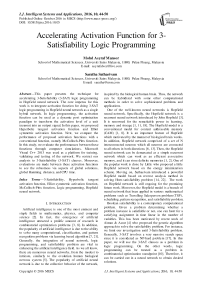Accelerating Activation Function for 3-Satisfiability Logic Programming
Автор: Mohd Asyraf Mansor, Saratha Sathasivam
Журнал: International Journal of Intelligent Systems and Applications(IJISA) @ijisa
Статья в выпуске: 10 vol.8, 2016 года.
Бесплатный доступ
This paper presents the technique for accelerating 3-Satisfiability (3-SAT) logic programming in Hopfield neural network. The core impetus for this work is to integrate activation function for doing 3-SAT logic programming in Hopfield neural network as a single hybrid network. In logic programming, the activation function can be used as a dynamic post optimization paradigm to transform the activation level of a unit (neuron) into an output signal. In this paper, we proposed Hyperbolic tangent activation function and Elliot symmetric activation function. Next, we compare the performance of proposed activation functions with a conventional function, namely McCulloch-Pitts function. In this study, we evaluate the performances between these functions through computer simulations. Microsoft Visual C++ 2013 was used as a platform for training, validating and testing of the network. We restrict our analysis to 3-Satisfiability (3-SAT) clauses. Moreover, evaluations are made between these activation functions to see the robustness via aspects of global solutions, global Hamming distance, and CPU time.
3-Satisfiability, Hyperbolic tangent activation function, Elliot symmetric activation function, McCulloch-Pitts function, Logic programming, Hopfield neural network
Короткий адрес: https://sciup.org/15010865
IDR: 15010865
Список литературы Accelerating Activation Function for 3-Satisfiability Logic Programming
- S. Sathasivam, P. F. Ng, and N. Hamadneh, Developing agent based modelling for reverse analysis method, Journal of Applied Sciences, Engineering and Technology 6 (2013) 4281-4288.
- R. Rojas, Neural Networks: A Systematic Introduction, Berlin: Springer, 1996.
- J. J. Hopfield and D. W. Tank, Neural computation of decisions in optimization problems, Biological Cybernatics 52 (1985) 141-151.
- U. Aiman and N. Asrar, Genetic algorithm based solution to SAT-3 problem, Journal of Computer Sciences and Applications 3 (2015) 33-39.
- S. Haykin, Neural Networks: A Comprehensive Foundation, New York: Macmillan College Publishing, 1999.
- G. Pinkas, and R. Dechter, Improving energy connectionist energy minimization, Journal of Artificial Intelligence Research 3 (1995) 223-237.
- W. A. T. Wan Abdullah, The logic of neural networks. Physics Letters A 176 (1993) 202-206.
- K. Bekir and A. O. Vehbi, Performance analysis of various activation functions in generalized MLP architectures of neural network. International Journal of Artificial Intelligence and Expert Systems 1(4) (2010) 111-122.
- P. Sibi, S. A. Jones and P. Siddarth, Analysis of different activation functions using back propagation neural networks. Journal of Theoretical and Applied Information Technology 47 (2013) 1264-1268.
- R. A. Kowalski, Logic for problem solving, New York: Elsevier Science Publishing Co, 1979.
- Y. L. Xou and T. C. Bao, Novel global stability criteria for high-order Hopfield-type neural networks with time-varying delays, Journal of Mathematical Analysis and Applications 330 (2007) 144-15.
- N. Siddique and H. Adeli, Computational Intelligence Synergies of Fuzzy Logic, Neural Network and Evolutionary Computing, United Kingdom: John Wiley and Sons, 2013.
- B. Sebastian, H. Pascal and H. Steffen, Connectionist model generation: A first-order approach, Neurocomputing 71(13) (2008) 2420-2432.
- S. Sathasivam, Upgrading Logic Programming in Hopfield Network, Sains Malaysiana, 39 (2010) 115-118.
- B. Tobias and K. Walter, An improved deterministic local search algorithm for 3-SAT, Theoretical Computer Science 329 (2004) 303-313.
- D. Vilhelm, J. Peter and W. Magnus, Counting models for 2SAT and 3SAT formulae, Theoretical Computer Science, 332 (2005) 265-291.
- L. J. James, A neural network approach to the 3-Satisfiability problem, Journal of Parallel and Distributed Computing 6(2) (1989) 435-449.
- H. Asgari, Y. S. Kavian, and A. Mahani, A Systolic Architecture for Hopfield Neural Networks. Procedia Technology, 17 (2014) 736-741.
- P. Steven, SAT problems with chains of dependent variables, Discrete Applied Mathematics 130(2) (2003) 329-22.
- K. Ernst, B. Tatiana and C. W. Donald, Neural Networks and Micromechanics, New York: Springer Science & Business Media, 2009.
- C. Rene and L. Daniel, Mathematical Logic: Propositional Calculus, Boolean Algebras, Predicate Calculus, United Kingdom: Oxford University Press, 2000.
- M. Kaushik. Comparative analysis of exhaustive search algorithm with ARPS algorithm for motion estimation. International Journal of Applied Information Systems 1(6) (2012) 16-19.


